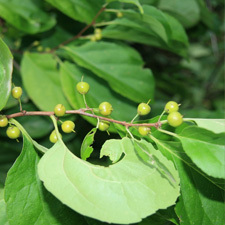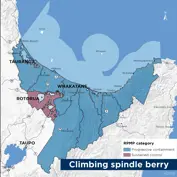 Climbing spindle berry
Climbing spindle berry
Common name: Climbing spindle berry
Botanical name: Celastrus orbiculatus
Management programme: Progressive Containment, Sustained Control
Native of Japan, China and Korea. Brought to New Zealand as an ornamental plant, the flexible stems can be used for wreaths.
Why is it a pest?
- The stems of climbing spindle berry strangle hosts and climb to the top of most canopies, causing them to collapse.
- Stems become dense, forming impenetrable thickets.
- Climbing spindle berry eventually forms a dense blanket of growth which smothers and eventually kills trees and shrubs beneath.
- It is shade tolerant and is a significant threat to native bush.
- All parts of the plant are poisonous.
- Seeds are viable for 2-5 years and spread by birds which are attracted to the fruit.
- Climbing spindle berry also spreads by sending out runners which extend large distances.
Where is it found?
Present throughout the Bay of Plenty, with majority of sites found in Rotorua. Climbing spindle berry can be found in roadside vegetation, forestry, and native bush.
What does it look like?
- A vigorous, deciduous, woody stemmed climber which grows up to 15m into trees.
- Young green twigs often have sharp spines.
- Roundish, alternate, finely serrated leaves turn bright yellow in autumn before dying off over winter.
- Pale green, insignificant flowers in November followed by round yellow/ orange/ red seed capsules that split to expose scarlet centres.
- The best time to spot climbing spindle berry is in autumn when the leaves are a golden yellow.
What are the rules?
Climbing spindle berry is listed as Progressive Containment in some parts of the region and Sustained Control in other parts. Please see the map below to identify which rules apply to your area.
Progressive Containment
Progressive Containment species are pests which the Council aims to prevent from spreading, reduce the distribution, or eradicate within parts of the region over time. Landowners or occupiers are responsible for the control of Progressive Containment species on their property. Council may enforce the control of these pest species.
Sustained Control
Sustained Control pests are well established in the region or parts of the region and preventing the spread is no longer a realistic objective. Management focuses on reducing general impacts of the pest. Landowners/ occupiers are responsible for the control of these pest species on their land. Council may enforce control.
In the areas identified in the map below occupiers must destroy climbing spindle berry if they are either within 200m of any property boundary where the adjoining occupier is also controlling it OR if required by a written direction from an authorised person
How do you get rid of it?
Climbing spindle berry is best controlled spring through to summer when it is actively growing.
Repeat treatments will be required for several years.
- Manual - seedlings and small plants can be pulled or dug out
- Cut and paint stump with herbicide
- Spraying
CAUTION: When using any herbicide or pesticide, PLEASE READ THE LABEL THOROUGHLY to ensure that all instructions and directions for the purchase, use and storage of the product, are followed and adhered to.
Read more on pest control advice, information and regulations.
Management category map
Images









